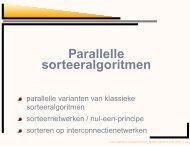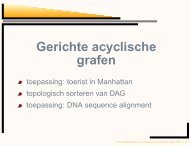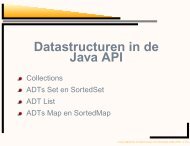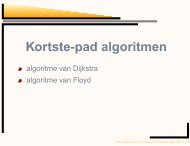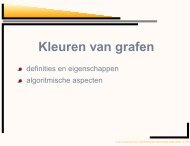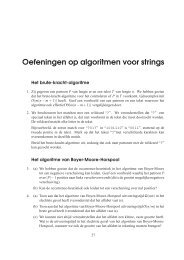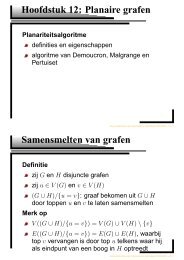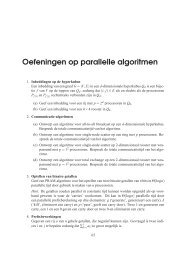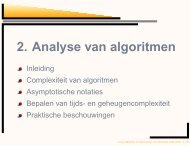Here - Combinatorial algorithms and algorithmic graph theory
Here - Combinatorial algorithms and algorithmic graph theory
Here - Combinatorial algorithms and algorithmic graph theory
You also want an ePaper? Increase the reach of your titles
YUMPU automatically turns print PDFs into web optimized ePapers that Google loves.
2 Introduction<br />
structure elucidation, the goal is to identify molecules. By analysing the mass<br />
spectrum of a substance, chemists can determine the chemical formula of the<br />
molecule of which the substance consists together with forbidden or forced substructures.<br />
One can then use a program to generate all structures which represent<br />
molecules with this chemical formula <strong>and</strong> forbidden/forced substructures<br />
<strong>and</strong> compute the spectrum of the generated structures. Then by comparing the<br />
computed spectra with the measured spectrum of the substance one can often<br />
propose a small list of c<strong>and</strong>idate structures. This helps to determine the structure<br />
of the molecule. The DENDRAL project [82] which was initiated in the sixties<br />
at Stanford University was the first project for the automatic recognition of the<br />
structure of molecules.<br />
In structure prediction, a generation algorithm is used to generate all <strong>graph</strong>s<br />
which represent molecules of a given class which have useful properties. One<br />
can then compute the chemical energy of each of the generated structures. The<br />
ones with the best energy are chemically the most stable ones <strong>and</strong> chemists can<br />
investigate their potential applications <strong>and</strong> the possibility to synthesise these<br />
molecules.<br />
Programs for generating models of fullerenes (see Chapter 4) have also been<br />
used by chemists to investigate the hypothesis that IPR fullerenes are chemically<br />
more stable than non-IPR fullerenes [1].<br />
Of course structure generation has also applications outside the field of mathematics<br />
or chemistry. Structure generation <strong>algorithms</strong> have for example already<br />
been used to determine the optimal pitch sequence of tires. The surface of a<br />
tire can contain several types of blocks, e.g. short, medium <strong>and</strong> long ones. The<br />
sequence of these blocks is called the pitch sequence of the tire. One pitch sequence<br />
can be more resistant to wear or have a lower noise level than another.<br />
So in order to determine the best pitch sequence, one can generate all possible<br />
pitch sequences (here the generated structures are not <strong>graph</strong>s) <strong>and</strong> compute the<br />
resistance to wear or noise level of each generated pitch sequence.<br />
In this thesis we develop <strong>algorithms</strong> for the generation of complete lists of<br />
<strong>graph</strong>s which have important applications in mathematics as well as generation<br />
<strong>algorithms</strong> which are important in chemistry.<br />
In principle one can generate all <strong>graph</strong>s from a specific <strong>graph</strong> class by using<br />
an existing algorithm to generate all <strong>graph</strong>s with a filter at the end which only<br />
outputs <strong>graph</strong>s which are part of the specific <strong>graph</strong> class. However for most<br />
<strong>graph</strong> classes this approach is very inefficient as often only a tiny percentage of<br />
all <strong>graph</strong>s are part of this <strong>graph</strong> class. For example only 0.000000057 percent of



